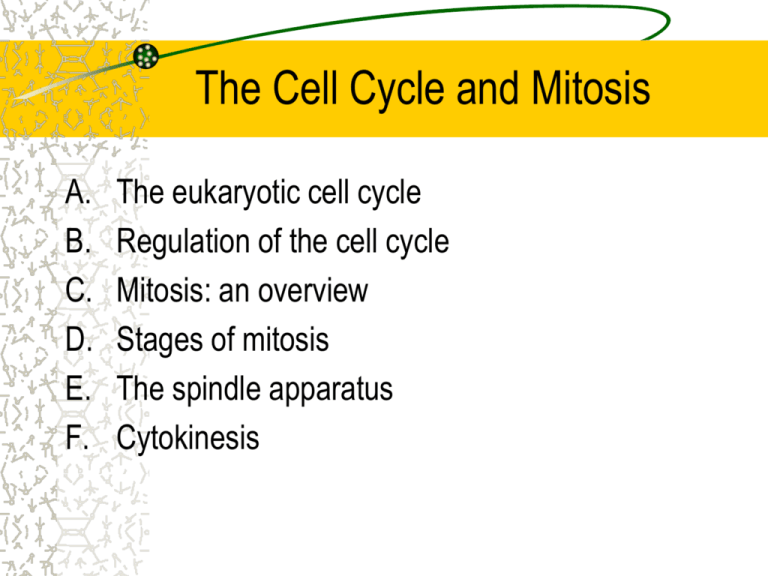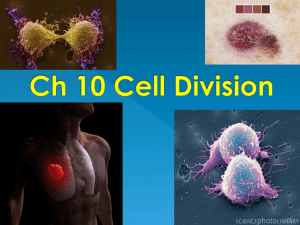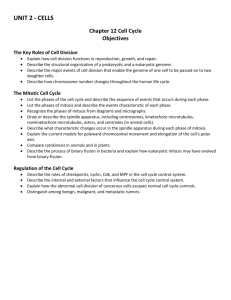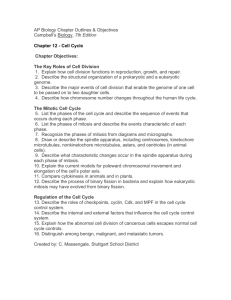The Cell Cycle and Mitosis
advertisement

The Cell Cycle and Mitosis A. B. C. D. E. F. The eukaryotic cell cycle Regulation of the cell cycle Mitosis: an overview Stages of mitosis The spindle apparatus Cytokinesis A. The Eukaryotic Cell Cycle Eukaryotic cell cycle: – A series of stages through which most eukaryotic cells pass during some time in their development – In single-celled eukaryotes, the cell cycle often represents the major mechanism for asexual reproduction of the species – In multicellular eukaryotes, the cell cycle is used for cellular reproduction in embryonic cells and stem cells A. The Eukaryotic Cell Cycle Key events of the cell cycle – Interphase: a period of extensive metabolic & synthetic activity – During this time the DNA (chromosomes) of the cell are replicated – Mitosis: the nucleus of the cell divides to form two identical nuclei, with each new nucleus having the same number of chromosomes as the parent nucleus – Cytokinesis: in most cases (with some exceptions), the cell’s cytoplasm divides to form two cells, each containing one of the new nuclei A. The Eukaryotic Cell Cycle Stages of the cell cycle – G1 (gap-1) is the period before chromosomal replication takes place – S (synthesis) is the period when the chromosomes are replicated – G2 (gap-2) is the period following chromosomal replication – M (mitosis) is the period of nuclear division A. The Eukaryotic Cell Cycle G1, S, and G2 are collectively called “interphase,” characterized by: – The presence of a well-defined nucleus – Individual chromosomes are not visible – Chromatin: chromosomes are dispersed in an uncondensed state called chromatin; “Grainy” or “sandy ” appearance – Nucleolus: a dark-staining spot sometimes (but not always) seen in the interphase nucleus; The site of ribosome synthesis B. Regulation of the Cell Cycle In multicellular eukaryotes, dividing cells are found: – In embryonic tissue; – In certain tissues that are constantly renewed, such as bone marrow stem cells or plant meristems; – In damaged tissue, such as cell division in damaged liver B. Regulation of the Cell Cycle Go (stationary) cells: cells that have reached terminal differentiation and no longer divide Cells stop dividing before they enter “S” phase; Therefore, Go is similar in some respects to G1 except that the cell does not enter “S” phase The cell cycle is regulated by several types of regulatory proteins that act at two major points: the G1 – S junction, and the G2 – M junction C. Mitosis: An Overview a) During G1 each chromosome is uncondensed and in an unreplicated state. C. Mitosis: An Overview b) In the S phase, each chromosome is replicated. The replicated chromosome consists of two sister chromatids attached at the centromere. C. Mitosis: An Overview c) At the beginning of mitosis, the chromosomes condense and become visible. Note that the chromosome is still in a replicated state, with a pair of chromatids attached at the centromere. C. Mitosis: An Overview d) During mitosis: the centromere splits, the chromatids separate and become daughter chromosomes, and the daughter chromosomes move to opposite sides of the cell. C. Mitosis: An Overview e) At the end of mitosis, the chromosomes on each side of the cell decondense and form two new, identical nuclei. D. Stages of Mitosis Prophase: – The nuclear membrane and nucleolus disperse – The chromatin condenses to form visible chromosomes – The mitotic spindle apparatus begins to form D. Stages of Mitosis Metaphase – The chromosomes line up along the equator of the spindle apparatus – Some writers use the term “prometaphase” to represent the transitional state between prophase & metaphase Anaphase – The centromeres split and the daughter chromosomes move to opposite poles of the spindle apparatus D. Stages of Mitosis Telophase – At each pole of the spindle, the chromosomes decondense and return to the state of chromatin – New nuclear membranes and nucleoli form at each spindle pole, completing the formation of two new identical nuclei E. The Spindle Apparatus Composed of microtubules: fibers that are dynamically assembled from the protein tubulin Centrosomes: – Found at the poles of the spindle in animal cells – Each centrosome consists of two centrioles: short tubulin structures that help to regulate tubulin polymerization – In plant cells: plant cells have “microtubuleorganizing centers” (instead of centrosomes) at each pole E. The Spindle Apparatus Some fibers are attached to chromatids – Each attached fiber is connected to the kinetochore of the chromatid: a region near (or at) the centromere The movement of chromatids is accomplished by shortening of the kinetochore fibers – This is done by depolymerization of the microtubules at the spindle poles E. The Spindle Apparatus Chemicals that inhibit microtubule formation (such as colchicine) cause mitosis to stop at metaphase Colchicine and similar chemicals are used to arrest mitosis at metaphase for the purpose of chromosomal analysis (karyotyping) F. Cytokinesis In animal cells: – Cytokinesis is accomplished by the formation of the cleavage furrow – A contractile ring or “girdle” of actin fibers and myosin (a transient muscle-like assembly) forms just inside the plasma membrane, around the equatorial plate – The contractile ring pulls the plasma membrane together to pinch the cell into two cells F. Cytokinesis In plant cells: – Cytokinesis is accomplished by the formation of the cell plate – Cell plate: A new cell wall forming at the equatorial plate – The cell plate enlarges until it completely separates the cell into two cells





